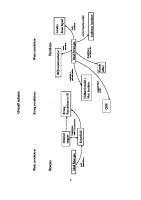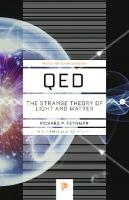A Theory of Matter and Electricity
347 94 840KB
English Pages 6 Year 1927
Recommend Papers
File loading please wait...
Citation preview
MA THEMA TICS: G. D. BIRKHOFF
160
PROC. N. A. S.
Finally, to show that the series (6) is a bonafide generalization of Taylor's series, note that for 4i(x) = 1, for which Conditions B are satisfied, (6) reduces to Taylor's series. Conditions B are also satisfied if x
0'(x)
=
e n,
and for these values one is led to a series quite different from Taylor's series. * NATIONAL RuSzE3ARCH FZLLOW. 'Bul. Sci. Math. Astr., 25, p. 200. E. Goursat, Cours d'Analyse Mathfnatique, vol. 2, p. 430. 3 Math. Ann., 75, p. 449.
2
A THEORY OF MATTER AND ELECTRICITY' By GZORGT D. BIRKHOFp DZPARTMZNT OF MATHICMATICS, HARvAR UNIVERSITY
Communicated January 22, 1927
Up to the present time no mathematical theory of matter and electricity seems to have been proposed which meets the fundamental demands of determinateness and stability. A theory which appears to satisfy these demands is presented herewith. In a second following note it is proved that this theory leads to a formula of the Balmer type for the frequencies of the small oscillations of a hydrogen atom. 1. The Perfect Fluid.-We consider first the space-time of the special theory of relativity with time coordinate xi and rectangular space coordinates x2, X3, X4, the units of length and time being so chosen that the velocity of light is 1. By an "adiabatic fluid" is meant matter whose state is determined by a functionally related pressure and density, p and p such that if ui = dxilds denotes the velocity tensor, and if the "energy tensor" is defined to be
Tii
1) puivu - pg' (g= 0,i $£j; gll = _g22 = g33 = -g44- 1), then the equations of motion are obtained by setting 0 (2) =
.=
6Xa
These equations express the relativistic form of the principles of conservation of energy (i = 1) and of linear momentum in the direction of the three axes (i = 2, 3, 4). From them it appears that a certain quantity
VOL. 13, 1927
MA THEMATICS: G. D. BIRKHOFF
161
dp
fpe r dr (dT, element of volume) (3) has always the same value over any given portion of the fluid ;2 for example, if p = p, it is the volume fdr which is invariable. Under the action of an arbitrary body force tensor f , the only modification necessary is to replace the right-hand member of (2) byf. It is understood that the only forces allowed must be orthogonal to the velocity tensor, i.e., f*ua = 0. A possible state of equilibrium of such a fluid is that of constant pressure and density. If one computes the velocity of a slight disturbance from this state, it turns out to be a'/1/(1-a)'/1 where we write a = dp/dp.3 Of course, the velocity of such an elastic disturbance cannot exceed that of light. On the other hand, if that velocity is less than that of light, difficulties of indeterminateness seem to arise when two portions of the adiabatic fluid collide at relative velocities sufficiently near the velocity of light. In order to avoid this difficulty of indeterminateness, it seems to be necessary to have a disturbance velocity equal to that of light at all pressures and densities. Such a fluid, for which p = /2p, will be termed the "perfect fluid," by analogy with an ordinary perfect gas. 2. Electricity and the Perfect Fluid.-If Fij is a skew-symmetric tensor of the second order so that Fij =-Fji then the tensor f
=
yields a force tensor which is in all cases orthogonal to the velocity tensor. We will regard F12, F13, F14 as the components of electric force and -F3 -F42, -F23 as the components of magnetic force. The well-known Maxwell-Lorentz equations may then be written in the form + ,F,k+ (4) +F*- OO, :F-_47raui, bXk bxj axi aX, where a is the density of electricity. From these it follows that the total charge a is invariable, so that electricity may be regarded as a substance. Now we suppose that the perfect fluid is permanently charged with electricity of which it acts as the carrier. More precisely if we define the "electromagnetic energy tensor" as
Eij= FiaFaj + 41 F,Fagij,
(5)
the ponderomotive equations for combined matter and electricity take a form like (2) except that the energy tensor Tij of matter is replaced by Tij + Eij, i.e., by the combined energy tensor of the perfect fluid and of elec-
tricity. Since the quantity (3), as well as the electrical charge is invariable it
162
MA THEMA TICS: G. D. BIRKHOFF
Po.N. A. S.
follows that these must remain in a constant ratio along any world line of the fluid. For the case of the perfect fluid this leads at once to the equation
(6) p
a
(6)
is the constant ratio referred to with the divisor VT introHere ip/ duced for the sake of convenience. The quantity p will be termed the "substance coefficient."4 It is an arbitrary function of position, specified once for all at the outset and remaining fixed in value along each world line of the fluid. Since electricity of one sign repels itself, and since the perfect fluid tends to expand under the enormous elastic pressures, the charged perfect fluid tends to expand all the more with velocities which approach that of light. Under such expansion the mass of the relativistic fluid approaches zero since the density of matter varies as the square of the density of electricity by. (6). 3. Atomic Potential Energy.-As a first step toward relieving the instability just referred to we propose to define an "atomic potential" Ap, given once for all at each particle of the fluid. In this case along the world line of a particle we have
df = .ua =0
ds -?Xa so that the tensor 4P/bxi may function as a second force tensor, being orthogonal to the velocity tensor. It is this further body force which we shall assume to be present in the fluid. If we define Aij = Agij (7) as the "atomic potential energy tensor," then the laws of motion for the perfect fluid under elastic, electrical and atomic potential forces may be expressed in the form (2) except that Tj is replaced by the complete energy tensor Hij = Tii + Eij + A4;, i.e., the equations of motion are ____ = 0.
(8)
)xa
It is to be remembered that in addition to these equations there is the constitutive equation p = l/2p as well as the Maxwell-Lorentz equations (4), and the equation -gu =0, (9) =
etXa
expressing the fact that ^,6 is constant along each world line.
VOL. 13, 1927
1163
MA THEMA TICS: G. D. BIRKHOFF
It would seem to be desirable that 1 be required to vanish along the free boundary of any portion of the perfect fluid. Otherwise there will be an inward normal pressure equal to y6, and the resultant of the internal body forces due to the atomic potential will not vanish. 4. The Conservation of Energy.-If one transforms properly the equation (8) for i = 1, it leads to a principle of the conservation of energy at low velocities in which v =f[p-p +-(F122 + *;+F232)+
] dr
(10)
figures as potential energy, so that only half the mass couhts an elastic energy. The electromagnetic energy density has the usual form. The atomic potential energy is proportional to the volume, and in consequence the volume cannot increase indefinitely. Here then is a first factor operating in the direction of stability. A portion of the fluid of one sign would tend to scatter in wisplike form in space rather than to fill all of space. For i = 2, 3, 4 the equation (8) expresses the principles of the conservation of linear momentum in the direction of the X2, X3, X4 axes, respectively. 5. Gravitation.-If now, in accordance with Einstein's general scheme for taking care of gravitational phenomena, we write
-'Rgi= R,j-2
(11)
and employ the same laws as before in the sense of the "principle of equivalence," an appropriate extension of the above theory of matter and electricity to the space-time of the general theory of relativity results. As is well known, the relations (8) then appear as implicit in (11). The gravitational effect of matter and energy is, however, not exactly proportional to the energy den-ity (see (10)) but is instead given by p
+-87r(F122 + ...
+
F232) + y6.
(12)
6. The Structure of Matter. Stability.-To obtain a theory of matter satisfying the fundamental requirements of determinateness and stability we may now proceed as follows. Let us suppose that the protons are initially portions of the perfect fluid carrying a charge e, and of one or more types of spherical distribution of sp, s6, a. These protons may collide with one another or with themselves, but by definition are not to interpenetrate. Similarly, certain other portions of the perfect fluid of one particular type carrying a charge -e constitute the electrons. Their mass is much less and the volume much greater than that of the protons. These may collide with one another, but by definition they cannot interpenetrate.
164
14MA THEMA TICS: G. D. BIRKHOFF
PROC. N. A. S.
If now we were to require that electrons and protons cannot interpenetrate it is readily proved that they tend to wisplike forms of finite volume with nearly neutralizing portions of positive' and negative electricity in every part. The natural way in which to avoid this difficultv of an amor-phous stable condition is to allow the free interpenetration of electron and proton. It is almost as though the proton were taken as a point charge which freely penetrates the electron, although this limiting case introduces the vital difficulty of infinite available energy. We, therefore, require the free interpenetration of the proton and electron. Howevel, there can be no three fluids overlapping at a point, since two of the same sign cannot overlap. The appropriate modification in the equations of motion is easily made. In the Maxwell-Lorentz equations (4) the current density tensor oui is replaced by a+uj + a-vi where o+ is the density of positive charge with velocity tensor ui while a is the density of the negative charge with velocity tensor vi. Similarly the energy tensors Tij and Aij are modified, respectively, to Ti= p+ uiuj + p- vivj- (p+ + p-)gij, Aij* = ('P+ + &-)gjj where the meaning of the notation is obvious. The equations (8) express as before the four conservation conditions, and follow at once from the equations of motion for the interpenetrating fluids. For example, for the proton these are °Xa
where fi is the electromagnetic force tensor for the proton,
fi = -0+FiaU*. In this way, even in the space-time of the general theory of relativity, -the modified equations are at once obtained. WXith such a set of requirements it is not hard to see that a position of stable equilibrium of any system of protons and electrons can be expected to appear. In fact none of the protons or electrons can contract indefinitely since that would require an infinite elastic potential energy. Nor can they expand indefinitely because of the atomic potential energy. And,- finally, -the electrical attractions between the oppositely charged protons and electrons, and their free interpenetration, tend to make them coalesce into neutral stable forms made up of a number of connected pairs of protons and electrons forming the individual atoms. 1 An outline of this theory was presented in an address entitled "A Mathematical Critique of Some Physical Theories," given before a meeting of Section A of the American Association for the Advancement of Science, The American Mathematical Society and the Mathematical Association of America on Dec. 30, 1926. The address will appear in full in an early number of the Bulletin of the American Mathematical Society.
VOL.. 13, 1927
MA THEMA TICS: G. D. BIRKHOFF
165
2 See my book, Relativity and Modern Physics, p. 100. 3 Pp. 104-105, loc. cit. 2. 4See my book, The Origin, Nature and Influence of Relativity, chap. 7.
THE HYDROGEN A TOM AND THE BALMER FORMULA By GEORGZ D. BTRKHOFF DEPARTMIENT OP MATHEMATICS, HARVARD UNIVSRSITY Communicated January 22, 1927
I propose to apply the theory of the preceding note to the consideration of the small oscillations of the proton and single electron forming the hydrogen atom. On making certain simple assumptions about the substance coefficients and atomic potentials at our disposal, characteristic difference frequencies are obtained which are of the same type as those given by the Balmer formula.' 1. The State of Equilibrium.-As stated at the end of the preceding note, we may expect more or less complete coalescence of the electron and proton in the spherical condition of equilibrium. Let f = + + _2 stand for the total density of charge. The radial electric force is clearly
F
=
4Jgr2or2dr
(1)
and will vanish at the boundary surface r = ro since the total charge is zero. The conditions for equilibrium reduce at once to two:
ar(-+ +20 p+2)+ +F=O;
a (_v- 2 +-2
) +o-F=O
when F has the the value given above. These equations show that the radial distributions of electrical densities and substance coefficients in equilibrium can be taken at pleasure for both the proton and electron, but that then the atomic potentials are uniquely determined. It is to be recalled that the arbitrary constants must be so taken that A+, y6vanish at the boundaries of the proton and electron, respectively. It seems clear that the simplest possible assumption to make in the choice of the arbitrary densities is that they are constant throughout and numerically equal; in this case the electrical force F vanishes everywhere, and the conditions for equilibrium reduce to + a+ 4+=-+a 27r
i-=
27r
+ a-
(2)








![Contemporary Kinetic Theory of Matter [1 ed.]
0521895472, 9780521895477](https://ebin.pub/img/200x200/contemporary-kinetic-theory-of-matter-1nbsped-0521895472-9780521895477.jpg)

